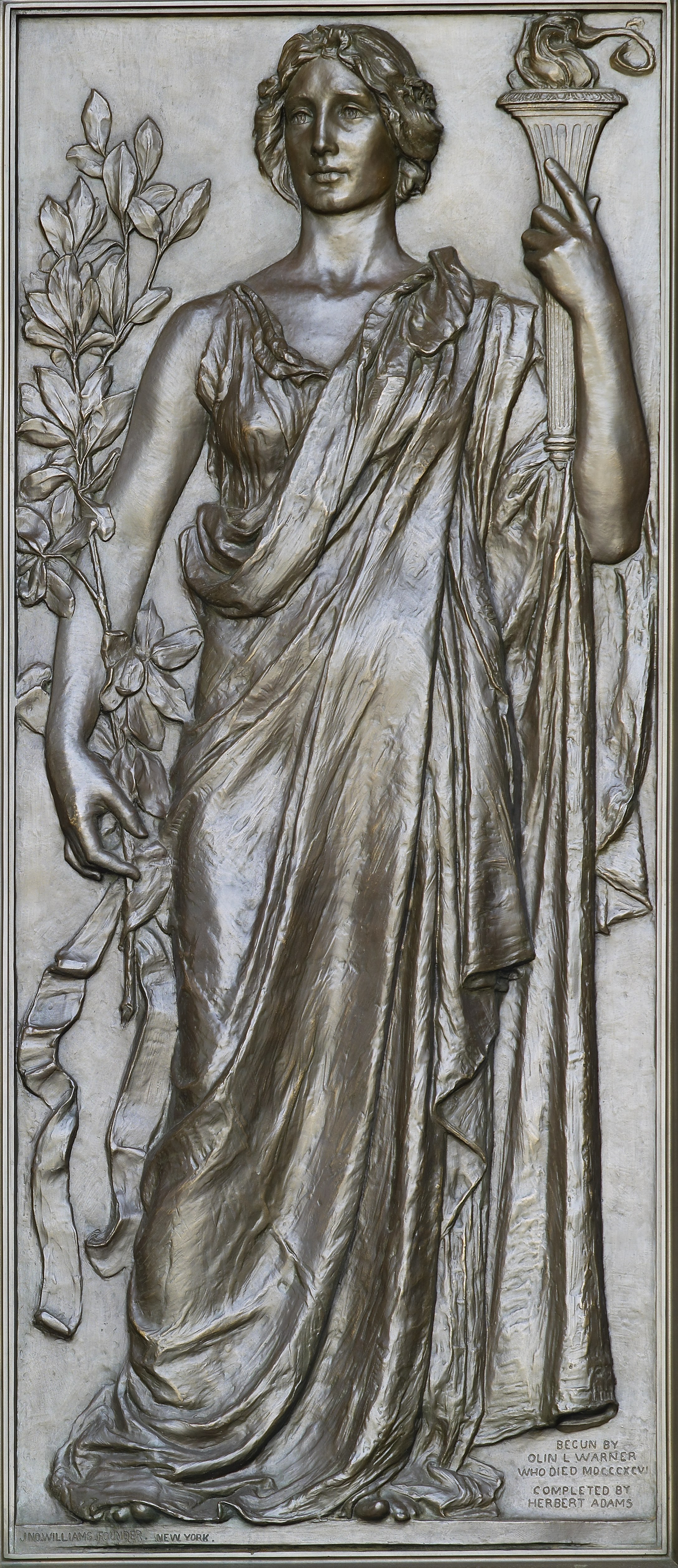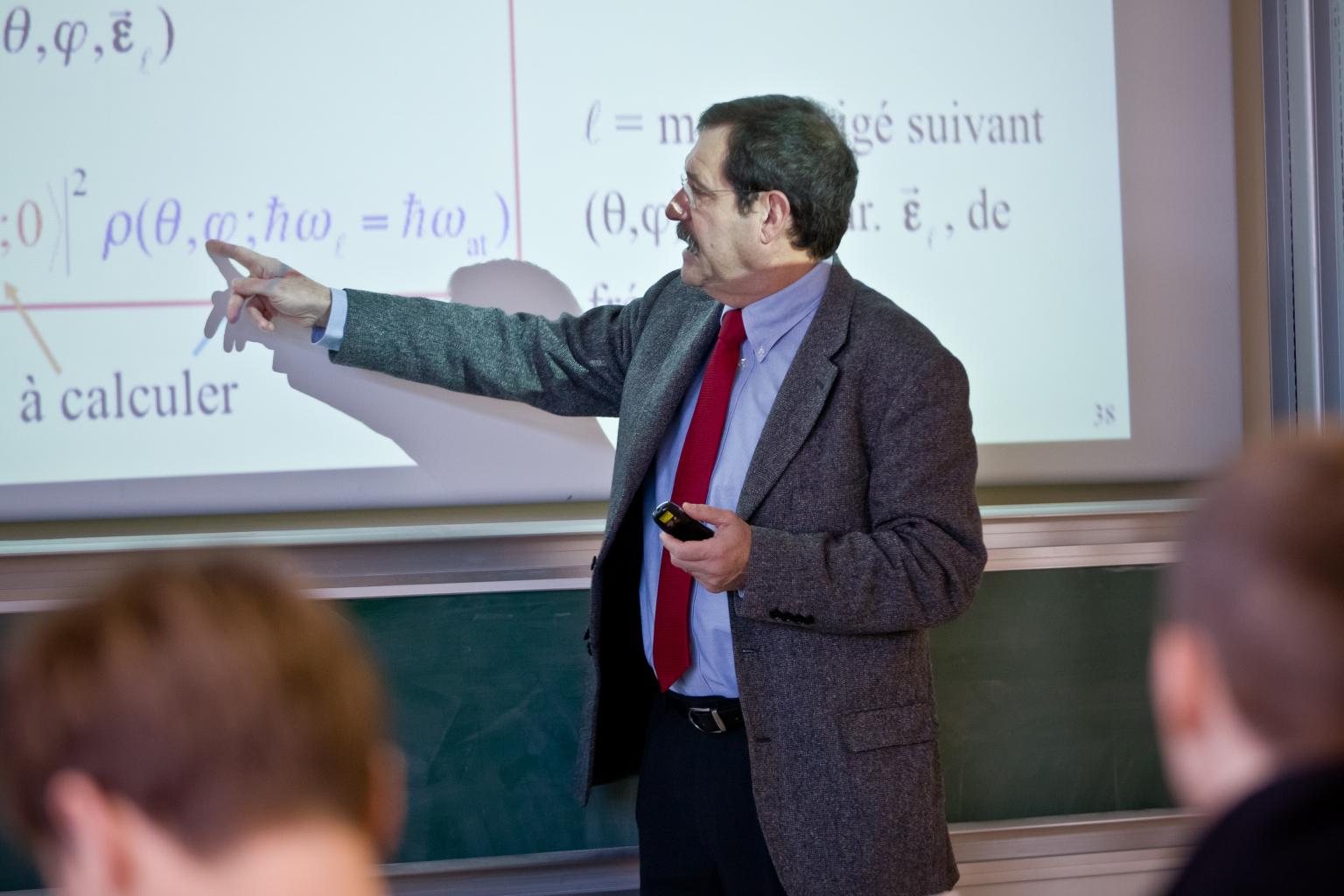|
Kastler–Brossel Laboratory
The Kastler–Brossel Laboratory, (formerly the Laboratory of Hertzian Spectroscopy) located in Paris, France, is a research laboratory specializing in fundamental physics of quantum systems. Founded in 1951 by Alfred Kastler and Jean Brossel, it is a joint research unit (French UMR 8552) operated by the French National Centre for Scientific Research (CNRS), the École normale supérieure, the Sorbonne University and the Collège de France. Brief history The laboratory was founded in 1951 by Alfred Kastler (Nobel Prize in Physics in 1966) and Jean Brossel on the theme of the interaction between light and matter. The initial name of laboratory was the « Laboratoire de spectroscopie Hertzienne de l'ENS » (Laboratory of Hertzian Spectroscopy). It is located in the Department of Physics of École normale supérieure. In 1967, a second site opened on the Jussieu campus. In 1994, the laboratory changed its name to « Laboratoire Kastler Brossel » in honor of its two founders. Now ... [...More Info...] [...Related Items...] OR: [Wikipedia] [Google] [Baidu] |
Fundamental Physics
In physics, the fundamental interactions, also known as fundamental forces, are the interactions that do not appear to be reducible to more basic interactions. There are four fundamental interactions known to exist: the gravity, gravitational and electromagnetism, electromagnetic interactions, which produce significant long-range forces whose effects can be seen directly in everyday life, and the strong interaction, strong and weak interactions, which produce forces at subatomic scale, minuscule, subatomic distances and govern nuclear interactions. Some scientists hypothesize that a fifth force might exist, but these hypotheses remain speculative. Each of the known fundamental interactions can be described mathematically as a ''field (physics), field''. The gravitational force is attributed to the curvature of spacetime, described by Albert Einstein, Einstein's general theory of relativity. The other three are discrete quantum field theory, quantum fields, and their interactions ... [...More Info...] [...Related Items...] OR: [Wikipedia] [Google] [Baidu] |
Franck Laloë
Franck Laloë (born May 28, 1940) is a French quantum physicist, author, and open archive initiator. He is emeritus research director at the French National Centre for Scientific Research (CNRS). Education and career Laloë was born in Rabat, Morocco and studied physics at the École Polytechnique in Paris from 1960 to 1962. His studied at University of Paris VI (later ''Pierre and Marie Curie University'') for a two-part doctorate. His PhD from 1963 to 1968 (Doctorat de troisième cycle) involved research on spin-polarized helium-3 systems. He obtained Doctorat d'État in 1970. He worked for the CNRS and became director from 1978. Later Laloë worked at the Kastler–Brossel Laboratory in Paris, where he was the director from 2004 to 2014. Laloë is the initiator of the open archive for scientific works, HAL, created in 2001 at the Centre pour la communication scientifique directe (CCSD) of the CNRS. He deals with digital archiving on optical media (CD and DVD) and is preside ... [...More Info...] [...Related Items...] OR: [Wikipedia] [Google] [Baidu] |
Research Institutes In France
Research is "creative and systematic work undertaken to increase the stock of knowledge". It involves the collection, organization and analysis of evidence to increase understanding of a topic, characterized by a particular attentiveness to controlling sources of bias and error. These activities are characterized by accounting and controlling for biases. A research project may be an expansion on past work in the field. To test the validity of instruments, procedures, or experiments, research may replicate elements of prior projects or the project as a whole. The primary purposes of basic research (as opposed to applied research) are documentation, discovery, interpretation, and the research and development (R&D) of methods and systems for the advancement of human knowledge. Approaches to research depend on epistemologies, which vary considerably both within and between humanities and sciences. There are several forms of research: scientific, humanities, artistic, economic ... [...More Info...] [...Related Items...] OR: [Wikipedia] [Google] [Baidu] |
Physics Laboratories
Physics is the natural science that studies matter, its fundamental constituents, its motion and behavior through space and time, and the related entities of energy and force. "Physical science is that department of knowledge which relates to the order of nature, or, in other words, to the regular succession of events." Physics is one of the most fundamental scientific disciplines, with its main goal being to understand how the universe behaves. "Physics is one of the most fundamental of the sciences. Scientists of all disciplines use the ideas of physics, including chemists who study the structure of molecules, paleontologists who try to reconstruct how dinosaurs walked, and climatologists who study how human activities affect the atmosphere and oceans. Physics is also the foundation of all engineering and technology. No engineer could design a flat-screen TV, an interplanetary spacecraft, or even a better mousetrap without first understanding the basic laws of physics. ... [...More Info...] [...Related Items...] OR: [Wikipedia] [Google] [Baidu] |
Christophe Salomon
Christophe Salomon (born in 1953) is a French physicist. Specialist in quantum optics and cold atoms, Christophe Salomon is interested in the superfluidity of quantum gases and in the measurement of time using atomic clocks. A pioneer in this disciplinary field, he has helped to give France a world leadership position in the field. Biography From 1973 to 1976, he was a student at the École centrale des arts et manufactures in Paris. He then defended his postgraduate thesis in 1979. He joined the CNRS in 1980 as a research fellow at the Laser Physics Laboratory, University of Paris-Nord. In 1984, he completed a thesis in high-resolution laser spectroscopy and then embarked on a post-doctoral fellowship at JILA, University of Colorado (USA). Fascinated by the first work in the United States on the manipulation of objects and atoms by laser, Christophe Salomon was introduced to these new techniques at the University of Colorado, before joining the first research group in France o ... [...More Info...] [...Related Items...] OR: [Wikipedia] [Google] [Baidu] |
Marie-Anne Bouchiat
Marie-Anne Bouchiat-Guiochon (born 1934) is a French experimental atomic physicist whose research has included studies of neutral currents, parity violation, and hyperpolarization. She is an honorary director of research for the French National Centre for Scientific Research (CNRS). Education and career Bouchiat was a student at the École normale supérieure de jeunes filles from 1953 to 1957, and a visiting researcher at Princeton University from 1957 to 1959. She completed a doctorate in 1964; her dissertation was ''Étude par pompage optique de la relaxation d'atomes de rubidium''. She worked as a researcher for CNRS from 1972, associated with the Kastler–Brossel Laboratory, until her retirement in 2005. Personal life Bouchiat married physicist Claude Bouchiat; two of their children, Hélène Bouchiat and Vincent Bouchiat, are also physicists. Recognition Bouchiat was elected as a corresponding member of the French Academy of Sciences in 1986, and a full member in ... [...More Info...] [...Related Items...] OR: [Wikipedia] [Google] [Baidu] |
French Academy Of Sciences
The French Academy of Sciences (French: ''Académie des sciences'') is a learned society, founded in 1666 by Louis XIV at the suggestion of Jean-Baptiste Colbert, to encourage and protect the spirit of French scientific research. It was at the forefront of scientific developments in Europe in the 17th and 18th centuries, and is one of the earliest Academies of Sciences. Currently headed by Patrick Flandrin (President of the Academy), it is one of the five Academies of the Institut de France. History The Academy of Sciences traces its origin to Colbert's plan to create a general academy. He chose a small group of scholars who met on 22 December 1666 in the King's library, near the present-day Bibliothèque Nationals, and thereafter held twice-weekly working meetings there in the two rooms assigned to the group. The first 30 years of the Academy's existence were relatively informal, since no statutes had as yet been laid down for the institution. In contrast to its Brit ... [...More Info...] [...Related Items...] OR: [Wikipedia] [Google] [Baidu] |
Jean Dalibard
Jean Dalibard (born 8 December 1958) is a French physicist, Professor at the École Polytechnique, member of the French Academy of Sciences and a researcher at the École Normale Supérieure. In 2009, Dalibard received the Blaise Pascal medal of the European Academy of Sciences for "his outstanding and influential works in atomic physics and quantum optics". In 2012, he received the Max Born Award and Davisson–Germer Prize. He was elected an international member of the American Philosophical Society in 2018. In 2020, he was honoured to be an international member of the National Academy of Sciences. See also * Quantum jump method References External links * Lecture A lecture (from Latin ''lēctūra'' “reading” ) is an oral presentation intended to present information or teach people about a particular subject, for example by a university or college teacher. Lectures are used to convey critical infor ...s ''Mécanique quantique'' [...More Info...] [...Related Items...] OR: [Wikipedia] [Google] [Baidu] |
Alain Aspect
Alain Aspect (; born 15 June 1947) is a French physicist noted for his experimental work on quantum entanglement. Aspect was awarded the 2022 Nobel Prize in Physics, jointly with John Clauser and Anton Zeilinger, "for experiments with entangled photons, establishing the violation of Bell inequalities and pioneering quantum information science". Education Aspect is a graduate of the École Normale Supérieure de Cachan (ENS Cachan, today part of Paris-Saclay University). He passed the ''agrégation'' in physics in 1969 and received his PhD degree in 1971 from the École supérieure d'optique (later known as Institut d'Optique Graduate School) of Université d'Orsay (later known as Université Paris-Sud). He then taught for three years in Cameroon as a replacement for then compulsory military service. In the early 1980s, while working on his doctorat d'État (habilitation thesis), he performed the Bell test experiments that showed that Albert Einstein, Boris Podolsky and ... [...More Info...] [...Related Items...] OR: [Wikipedia] [Google] [Baidu] |
Serge Haroche
Serge Haroche (born 11 September 1944) is a French-Moroccan physicist who was awarded the 2012 Nobel Prize for Physics jointly with David J. Wineland for "ground-breaking experimental methods that enable measuring and manipulation of individual quantum systems", a study of the particle of light, the photon. This and his other works developed laser spectroscopy. Since 2001, Haroche is a professor at the Collège de France and holds the chair of quantum physics. In 1971 he defended his doctoral thesis in physics at the University of Paris VI: his research had been conducted under the direction of Claude Cohen-Tannoudji. Early life and education Haroche was born in Casablanca, Morocco, to Albert Haroche (1920–1998), from a Moroccan Jewish family, and Valentine Haroche, born Roubleva (1921–1998) a teacher who was born in Odessa to a Jewish family of physicians who relocated to Morocco in the early 1920s. His father, a lawyer trained in Rabat, was one of seven children b ... [...More Info...] [...Related Items...] OR: [Wikipedia] [Google] [Baidu] |
Claude Cohen-Tannoudji
Claude Cohen-Tannoudji (; born 1 April 1933) is a French physicist A physicist is a scientist who specializes in the field of physics, which encompasses the interactions of matter and energy at all length and time scales in the physical universe. Physicists generally are interested in the root or ultimate ca .... He shared the 1997 Nobel Prize in Physics with Steven Chu and William Daniel Phillips for research in methods of laser cooling and trapping atoms. Currently he is still an active researcher, working at the École normale supérieure (Paris). Early life Cohen-Tannoudji was born in Constantine, Algeria, Constantine, French Algeria, to Algerian Jewish parents Abraham Cohen-Tannoudji and Sarah Sebbah. When describing his origins Cohen-Tannoudji said: "My family, originally from Tangier, settled in Tunisia and then in Algeria in the 16th century after having fled Spain during the Inquisition. In fact, our name, Cohen-Tannoudji, means simply the Cohen family from Tangier ... [...More Info...] [...Related Items...] OR: [Wikipedia] [Google] [Baidu] |


